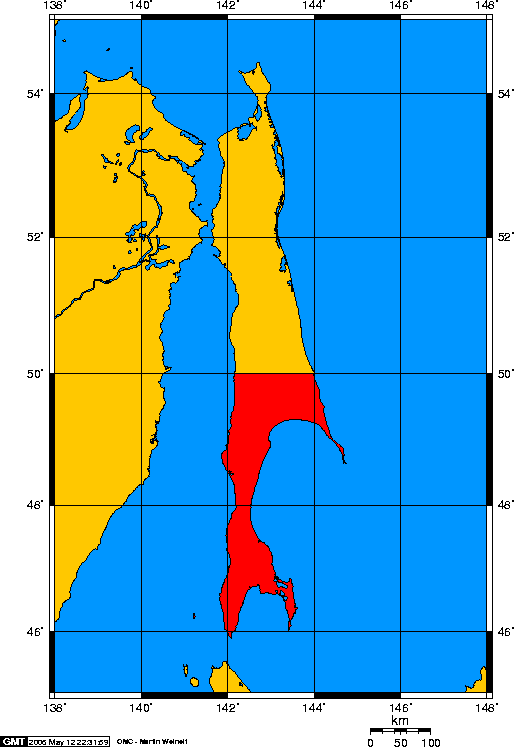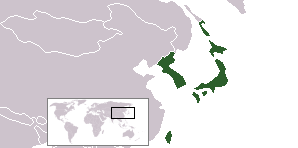|
Karafuto Prefecture
, was established by the Empire of Japan in 1907 to govern the southern part of Sakhalin. This territory became part of the Empire of Japan in 1905 after the Russo-Japanese War, when the portion of Sakhalin south of 50°N was ceded by the Russian Empire under the Treaty of Portsmouth. Karafuto Prefecture was established in 1907 to govern Karafuto, which was part of Japan's External Land (''Gaichi''), until it was incorporated into an Inner Land (''Naichi'') of the Japanese metropole in 1943. Ōtomari (Korsakov) was the capital of Karafuto from 1905 to 1908 and Toyohara (Yuzhno-Sakhalinsk) from 1908 to 1945. In August 1945, the Japanese administration ceased to function following the invasion of South Sakhalin by the Soviet Union. Karafuto Prefecture was annexed to the Soviet Union, although it continued to exist under Japanese law until it was formally abolished by Japan in June 1949. Name The Japanese name ''Karafuto'' purportedly comes from Ainu (), which means ... [...More Info...] [...Related Items...] OR: [Wikipedia] [Google] [Baidu] |
Empire Of Japan
The Empire of Japan, also known as the Japanese Empire or Imperial Japan, was the Japanese nation state that existed from the Meiji Restoration on January 3, 1868, until the Constitution of Japan took effect on May 3, 1947. From Japan–Korea Treaty of 1910, 1910 to Japanese Instrument of Surrender, 1945, it included the Japanese archipelago, the Kuril Islands, Kurils, Karafuto Prefecture, Karafuto, Korea under Japanese rule, Korea, and Taiwan under Japanese rule, Taiwan. The South Seas Mandate and Foreign concessions in China#List of concessions, concessions such as the Kwantung Leased Territory were ''de jure'' not internal parts of the empire but dependent territories. In the closing stages of World War II, with Japan defeated alongside the rest of the Axis powers, the Japanese Instrument of Surrender, formalized surrender was issued on September 2, 1945, in compliance with the Potsdam Declaration of the Allies of World War II, Allies, and the empire's territory subsequent ... [...More Info...] [...Related Items...] OR: [Wikipedia] [Google] [Baidu] |
Gaichi
is a term used to distinguish Japan's core land area from its outlying territories. "Mainland Japan" was an official term in the pre-war period, distinguishing Japan proper from its overseas territories (外地, ''gaichi'', lit. "outer lands") in the Far East, such as Japanese Taiwan, Japanese Korea, Karafuto, the South Seas Mandate, and the Kwantung Leased Territory. After the end of World War II, its usage became less common and lost its previous legal significance. The term's literal Japanese meaning might best be translated as "inner Japan" or "inner lands". The term "mainland" is somewhat inaccurate since it usually refers to all or part of a continental landmass, rather than islands. Today, the term is sometimes colloquially used to distinguish the country's four largest islands (Hokkaidō, Honshū, Kyūshū, and Shikokū) from smaller islands such as the Bonin Islands and the Ryukyu Islands, although these islands were considered part of Mainland Japan in the pre-war ... [...More Info...] [...Related Items...] OR: [Wikipedia] [Google] [Baidu] |
Japanese People
are an East Asian ethnic group native to the Japanese archipelago. Japanese people constitute 97.4% of the population of the country of Japan. Worldwide, approximately 125 million people are of Japanese descent, making them list of contemporary ethnic groups, one of the largest ethnic groups. Approximately 120.8 million Japanese people are residents of Japan, and there are approximately 4 million members of the Japanese diaspora, known as . In some contexts, the term "Japanese people" may be used to refer specifically to the Yamato people, who are primarily from the historically principal islands of Honshu, Kyushu and Shikoku and constitute by far the largest group. In other contexts, the term may include other groups native to the Japanese archipelago, including Ryukyuan people, who share connections with the Yamato but are often regarded as distinct, and Ainu people. In recent decades, there has also been an increase in the number of people with both Japanese and non-Japanes ... [...More Info...] [...Related Items...] OR: [Wikipedia] [Google] [Baidu] |
Karafuto Prefectural Office
, was established by the Empire of Japan in 1907 to govern the southern part of Sakhalin. This territory became part of the Empire of Japan in 1905 after the Russo-Japanese War, when the portion of Sakhalin south of 50°N was ceded by the Russian Empire under the Treaty of Portsmouth. Karafuto Prefecture was established in 1907 to govern Karafuto, which was part of Japan's External Land (''Gaichi''), until it was incorporated into an Inner Land (''Naichi'') of the Japanese metropole in 1943. Ōtomari (Korsakov) was the capital of Karafuto from 1905 to 1908 and Toyohara (Yuzhno-Sakhalinsk) from 1908 to 1945. In August 1945, the Japanese administration ceased to function following the invasion of South Sakhalin by the Soviet Union. Karafuto Prefecture was annexed to the Soviet Union, although it continued to exist under Japanese law until it was formally abolished by Japan in June 1949. Name The Japanese name ''Karafuto'' purportedly comes from Ainu (), which means . ... [...More Info...] [...Related Items...] OR: [Wikipedia] [Google] [Baidu] |
Korea Under Japanese Rule
From 1910 to 1945, Korea was ruled by the Empire of Japan under the name Chōsen (), the Japanese reading of "Joseon". Japan first took Korea into its sphere of influence during the late 1800s. Both Korea (Joseon) and Japan had been under policies of isolationism, with Joseon being a Tributary system of China, tributary state of Qing China. However, in 1854, Perry Expedition, Japan was forcibly opened by the United States. It then rapidly modernized under the Meiji Restoration, while Joseon continued to resist foreign attempts to open it up. Japan eventually succeeded in opening Joseon with the unequal Japan–Korea Treaty of 1876. Afterwards, Japan embarked on a decades-long process of defeating its local rivals, securing alliances with Western powers, and asserting its influence in Korea. Japan Assassination of Empress Myeongseong, assassinated the defiant Korean queen and intervened in the Donghak Peasant Revolution.Donald Keene, ''Emperor of Japan: Meiji and his World, 1852� ... [...More Info...] [...Related Items...] OR: [Wikipedia] [Google] [Baidu] |
Korean Language
Korean is the first language, native language for about 81 million people, mostly of Koreans, Korean descent. It is the national language of both South Korea and North Korea. In the south, the language is known as () and in the north, it is known as (). Since the turn of the 21st century, aspects of Korean Wave, Korean popular culture have spread around the world through globalization and Korean Wave, cultural exports. Beyond Korea, the language is recognized as a minority language in parts of China, namely Jilin, and specifically Yanbian Korean Autonomous Prefecture, Yanbian Prefecture, and Changbai Korean Autonomous County, Changbai County. It is also spoken by Sakhalin Koreans in parts of Sakhalin, the Russian island just north of Japan, and by the in parts of Central Asia. The language has a few Extinct language, extinct relatives which—along with the Jeju language (Jejuan) of Jeju Island and Korean itself—form the compact Koreanic language family. Even so, Jejuan and ... [...More Info...] [...Related Items...] OR: [Wikipedia] [Google] [Baidu] |
Manchu Language
Manchu ( ) is a critically endangered language, endangered Tungusic language native to the historical region of Manchuria in Northeast China. As the traditional native language of the Manchu people, Manchus, it was one of the official languages of the Qing dynasty (1644–1912) of China, although today the vast majority of Manchus speak only Mandarin Chinese. Several thousand can speak Manchu as a second language through governmental primary education or free classes for adults in classrooms or online. The Manchu language has high historical value for historians of China, especially for the Qing dynasty. Manchu-language texts supply information that is unavailable in Chinese, and when both Manchu and Chinese versions of a given text exist, they provide controls for understanding the Chinese. Like most Siberian languages, Manchu is an agglutinative language that demonstrates limited vowel harmony. It has been demonstrated that it is derived mainly from the Jurchen language thou ... [...More Info...] [...Related Items...] OR: [Wikipedia] [Google] [Baidu] |
Russian Language
Russian is an East Slavic languages, East Slavic language belonging to the Balto-Slavic languages, Balto-Slavic branch of the Indo-European languages, Indo-European language family. It is one of the four extant East Slavic languages, and is the native language of the Russians. It was the ''de facto'' and ''de jure'' De facto#National languages, official language of the former Soviet Union.1977 Soviet Constitution, Constitution and Fundamental Law of the Union of Soviet Socialist Republics, 1977: Section II, Chapter 6, Article 36 Russian has remained an official language of the Russia, Russian Federation, Belarus, Kazakhstan, Kyrgyzstan, and Tajikistan, and is still commonly used as a lingua franca in Ukraine, Moldova, the Caucasus, Central Asia, and to a lesser extent in the Baltic states and Russian language in Israel, Israel. Russian has over 253 million total speakers worldwide. It is the List of languages by number of speakers in Europe, most spoken native language in Eur ... [...More Info...] [...Related Items...] OR: [Wikipedia] [Google] [Baidu] |
Hokkaido
is the list of islands of Japan by area, second-largest island of Japan and comprises the largest and northernmost prefectures of Japan, prefecture, making up its own list of regions of Japan, region. The Tsugaru Strait separates Hokkaidō from Honshu; the two islands are connected by railway via the Seikan Tunnel. The largest city on Hokkaido is its capital, Sapporo, which is also its only cities designated by government ordinance of Japan, ordinance-designated city. Sakhalin lies about to the north of Hokkaidō, and to the east and northeast are the Kuril Islands, which are administered by Russia, though the four most southerly are Kuril Islands dispute, claimed by Japan. The position of the island on the northern end of the archipelago results in a colder climate, with the island seeing significant snowfall each winter. Despite the harsher climate, it serves as an agricultural breadbasket for many crops. Hokkaido was formerly known as ''Ezo'', ''Yezo'', ''Yeso'', or ''Yes ... [...More Info...] [...Related Items...] OR: [Wikipedia] [Google] [Baidu] |
Amur River
The Amur River () or Heilong River ( zh, s=黑龙江) is a perennial river in Northeast Asia, forming the natural border between the Russian Far East and Northeast China (historically the Outer and Inner Manchuria). The Amur ''proper'' is long, and has a drainage basin of .Амур (река в Азии) If including its main stem , the Argun, the Am ... [...More Info...] [...Related Items...] OR: [Wikipedia] [Google] [Baidu] |
Ainu Language
Ainu (, ), or more precisely Hokkaido Ainu (), is a language spoken by a few elderly members of the Ainu people on the northern Japanese island of Hokkaido. It is a member of the Ainu language family, itself considered a language family isolate with no academic consensus of origin. It is classified as Critically Endangered by the UNESCO ''Atlas of the World's Languages in Danger''. Until the 20th century, the Ainu languages – Hokkaido Ainu and the now-extinct Kuril Ainu and Sakhalin Ainu – were spoken throughout Hokkaido, the southern half of the island of Sakhalin and by small numbers of people in the Kuril Islands. Due to the colonization policy employed by the Japanese government, the number of Hokkaido Ainu speakers decreased through the 20th century, and it is now moribund. A very low number of elderly people still speak the language fluently, though attempts are being made to revive it. Speakers The term "Ainu" comes from the endonym of the Ainu people, ' (), ... [...More Info...] [...Related Items...] OR: [Wikipedia] [Google] [Baidu] |






